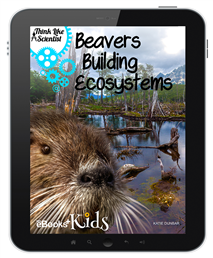Interactive eBook Introduces Young Readers to Beavers, Nature’s Furry Engineer
By Carole Hayward
Posted on 2019-02-12
 As a member of her local nature preserve, Katie Dunbar learned so much about the symbiotic relationship between animals and their environment. Take beavers, for example. The absence or presence of this one species has the ability to completely alter its ecosystem.
As a member of her local nature preserve, Katie Dunbar learned so much about the symbiotic relationship between animals and their environment. Take beavers, for example. The absence or presence of this one species has the ability to completely alter its ecosystem.
“Beavers are considered a keystone species for the vital role they play in their ecosystems,” said Dunbar, a K-5 librarian for the Palisades School District in Kintnersville, Pa. “If you remove them, the whole ecosystem changes. Their very existence ensures a healthy balance across plant life, animal species, and water levels.”
When Dunbar learned that NSTA was seeking authors, she wanted beavers to factor prominently in her storytelling. She admitted to having “great fun researching these fascinating, three feet-long little rodents” for her eBook+ Kids interactive book, Beavers Building Ecosystems.
While on a visit to Maine, Dunbar hunted down known beaver habitats, but admitted to being “completely surprised” upon discovering some of them.
“There was a huge variety in their dams, some of which I didn’t know were there until I stepped on them,” Dunbar said. “Between the trees and the brush, I couldn’t even tell that a pond was there.”
Dunbar’s eBook actively encourages K-5 students to participate in hands-on, three-dimensional learning. The content takes students through science and engineering practices; crosscutting concepts; and disciplinary core ideas. A detailed teachers’ guide supplements the e-book and can be used as a tool for class-wide, small group, or independent study of the content; provides additional ideas and activities; and assesses students on the content standards to which this e-book is aligned.
“The e-book allows students to make so many more connections with the content than if they were just reading a printed book,” Dunbar explained. “You can tell kids the connections, but they are not going to remember. If they get to interact with ideas and make connections themselves they will remember.”
Once considered a nuisance, more recent evidence points to the positive effects beavers have on ecosystem repair, esp. in the west, in managing storm water runoff, elevating low water tables, preventing river bed erosion, and creating of new wetlands.
“I hope that students who interact with this e-book get excited about this little critter who makes so many positive changes,” Dunbar said.
The author is hard at work on her second e-Book about pygmy mammoths. Did you know that the Chanel Islands are the only place in the world where pygmy mammoths are known to have existed? Dunbar shared that they evolved from the Columbian mammoths of North America after swimming out to the Chanel Islands.
Stay tuned!
Find out how to order Beavers Building Ecosystems.
Read an excerpt from the Teacher’s Guide.
Follow NSTA
Disclaimer: The views expressed in this blog post are those of the author(s) and do not necessarily reflect the official position of the National Science Teaching Association (NSTA).


